-
 Korea.net's 24-hour YouTube channel
Korea.net's 24-hour YouTube channel- NEWS FOCUS
- ABOUT KOREA
- EVENTS
- RESOURCES
- GOVERNMENT
- ABOUT US
King Gwanggaeto (r. 391-413), the 19th king of the Goguryeo Kingdom (37 B.C.-A.D. 668), is a well-remembered and much-respected historic figure. He is known to have developed national power and to have stabilized society during ancient times disturbed by territorial disputes.
During his reign, King Gwanggaeto brought his kingdom to its zenith, expanding his territory up into Manchuria, now part of northeast China, and down south to the Hangang River that today flows through Seoul.
The Goguryeo people used to call their king Guk-gang-sang-gwang-gae-to-gyeong-pyeong-an-ho-tae-wang (國岡上廣開土境平安好太王), which means, "a big lovely king who successfully expanded [the kingdom's] territory in the Gukgangsang region and brought stability to the nation." His people perceived him as a national leader who gave them not only expanded territory but peace and stability, too.
In recognition of his remarkable achievements, King Jangsu (r. 413-491), his successor, built the Gwanggaeto memorial stone that stands 6.39 meters high in the then capital of Guknaesung, now Jian City in Jilin Province, China.
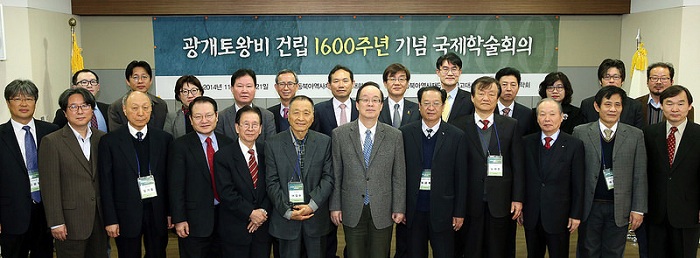
Some 1,600 years later, scholars from Korea, China and Japan gathered in Seoul on November 19 to share their research results into the ancient king and his times. Organized as a follow-up to a conference held at the end of October in Jian, China, this academic conference was organized by the Northeast Asian History Foundation on November 19. Researchers from the three nations presented 10 academic dissertations and led discussion sessions on a range of topics.
During the two-day conference, scholars exchanged their views and opinions about various topics, including the form of the stone memorial and rubbings of the inscriptions.
Researcher Shi ZhenXin (徐建新) of the Institute of World History at the Chinese Academy of Social Sciences gave a presentation about the Yo-jwa-il-gi (遼左日記), a diary written by Lee Cho-gyeong who contributed to an ink rubbing of the stone, discovered in Beijing in 2003. Based on this diary, Shi insists that the stone was discovered in 1877, rather than in 1880, the year currently thought to be correct.
Professor Geng TieHua (耿鐵華) of the Tonghua Normal University, a Goguryeo expert, unveiled his evaluations of rubbings of the stone that came on the auction market on September 6 in the Tonghua region of China. He posited that the inscription was carried out by a local technician in Jian City between the end of the 1920s and before the 1930s.
Researcher Baek Seung-ok of the Busan Museum insisted that the inscription rubbing in the Hye-Jung Museum at Kyunghee University, unveiled in February 2012, was probably engraved in gemstones very early on.
Professor Jo Beop-jong of Woosuk University said that the King Gwanggaeto memorial stone was built in the form of a pillar and was the first such stone in Northeast Asia that allowed inscriptions on all four sides. He insists that the stone had influence on other memorial pillars that were produced later on, such as the Chungju Goguryeo memorial stone, the Uljin-Bongpyeong monument, the Hwangchoryeong monument and the Maunryeong monument.
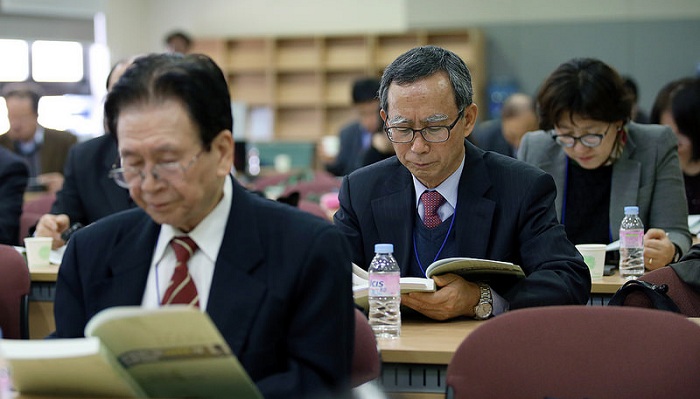
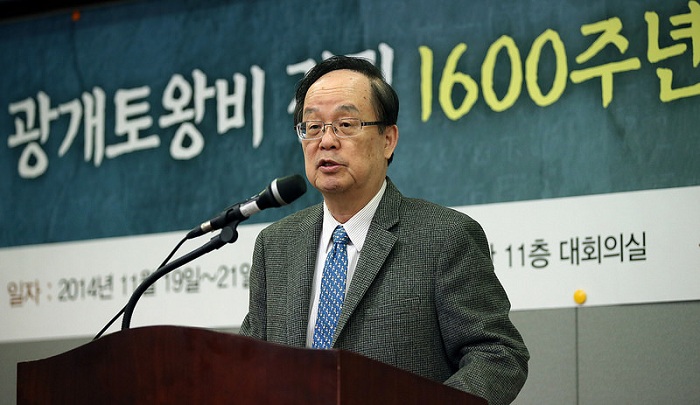
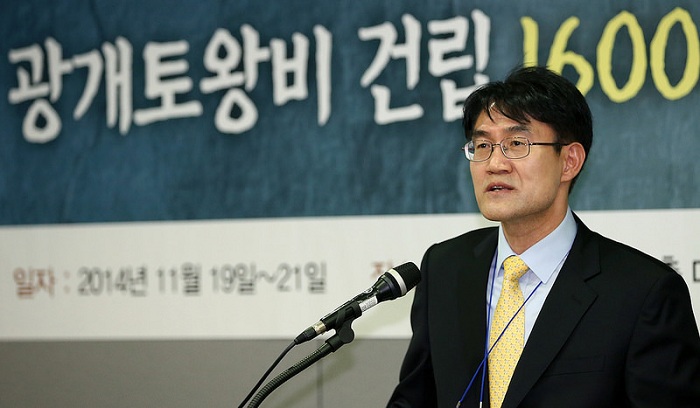
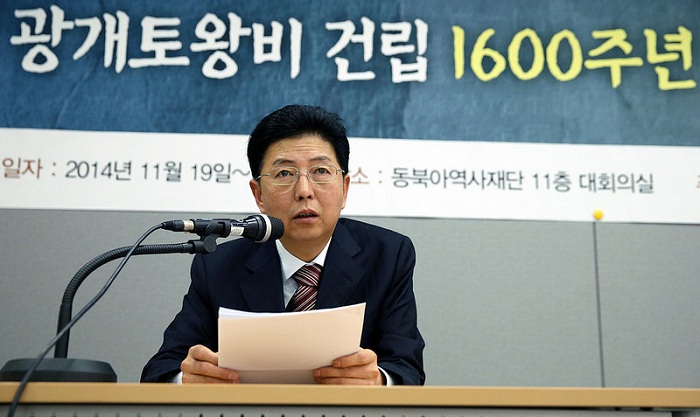
By Lee Seung-ah
Photos: Jeon Han
Korea.net Staff Writers
slee27@korea.kr
During his reign, King Gwanggaeto brought his kingdom to its zenith, expanding his territory up into Manchuria, now part of northeast China, and down south to the Hangang River that today flows through Seoul.
The Goguryeo people used to call their king Guk-gang-sang-gwang-gae-to-gyeong-pyeong-an-ho-tae-wang (國岡上廣開土境平安好太王), which means, "a big lovely king who successfully expanded [the kingdom's] territory in the Gukgangsang region and brought stability to the nation." His people perceived him as a national leader who gave them not only expanded territory but peace and stability, too.
In recognition of his remarkable achievements, King Jangsu (r. 413-491), his successor, built the Gwanggaeto memorial stone that stands 6.39 meters high in the then capital of Guknaesung, now Jian City in Jilin Province, China.

In celebration of the 1,600 years since the erection of the Gwanggaeto memorial stone, scholars from Korea, China and Japan all take part in an academic conference to share their research results.
Some 1,600 years later, scholars from Korea, China and Japan gathered in Seoul on November 19 to share their research results into the ancient king and his times. Organized as a follow-up to a conference held at the end of October in Jian, China, this academic conference was organized by the Northeast Asian History Foundation on November 19. Researchers from the three nations presented 10 academic dissertations and led discussion sessions on a range of topics.
During the two-day conference, scholars exchanged their views and opinions about various topics, including the form of the stone memorial and rubbings of the inscriptions.
Researcher Shi ZhenXin (徐建新) of the Institute of World History at the Chinese Academy of Social Sciences gave a presentation about the Yo-jwa-il-gi (遼左日記), a diary written by Lee Cho-gyeong who contributed to an ink rubbing of the stone, discovered in Beijing in 2003. Based on this diary, Shi insists that the stone was discovered in 1877, rather than in 1880, the year currently thought to be correct.
Professor Geng TieHua (耿鐵華) of the Tonghua Normal University, a Goguryeo expert, unveiled his evaluations of rubbings of the stone that came on the auction market on September 6 in the Tonghua region of China. He posited that the inscription was carried out by a local technician in Jian City between the end of the 1920s and before the 1930s.
Researcher Baek Seung-ok of the Busan Museum insisted that the inscription rubbing in the Hye-Jung Museum at Kyunghee University, unveiled in February 2012, was probably engraved in gemstones very early on.
Professor Jo Beop-jong of Woosuk University said that the King Gwanggaeto memorial stone was built in the form of a pillar and was the first such stone in Northeast Asia that allowed inscriptions on all four sides. He insists that the stone had influence on other memorial pillars that were produced later on, such as the Chungju Goguryeo memorial stone, the Uljin-Bongpyeong monument, the Hwangchoryeong monument and the Maunryeong monument.

Conference participants concentrate on the research results.



(From the top) President Kim Hak-joon of the Northeast Asian History Foundation, President Gong Suk-hu of the Association of Goguryeo Balhae, and Professor Park Chan-gyu of Yanbian University give presentations at the conference held in honor of the 1,600-year-old King Gwanggaeto memorial stone.
By Lee Seung-ah
Photos: Jeon Han
Korea.net Staff Writers
slee27@korea.kr
Most popular
- First hearing-impaired K-pop act hopes for 'barrier-free world'
- Event 'K-Beauty Hang Out' draws hundreds in Philippines
- Ceremony in Seoul inducts 2,641 content creators of Korean culture
- 'Mad Max' director impressed by 'cinema-literate' Korean viewers
- Cultural spring festival Seoul Festa to start on May 1














